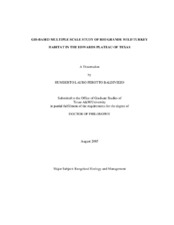GIS-based multiple scale study of Rio Grande wild turkey habitat in the Edwards Plateau of Texas
Abstract
Rio Grande wild turkey (RGWT) abundance in portions of the Edwards Plateau has declined steadily since the late 1970s as compared to other areas of the Edwards Plateau where populations have exhibited no trend. The reasons for this decline remain unclear. Possible factors include changes in habitat, and increased human population. The overall objective of this study was to identify landscape changes and habitat characteristics that affect RGWT populations using spatial analysis and modeling at multiple spatial scales. Specific objectives for this study included the quantification of flood-induced landscape changes between 1972 and 1995 along the Medina River bottomlands and their impact on RGWT habitat, the quantification of landscape characteristics of stable and declining study sites in the Edwards Plateau, and the development and evaluation of a GIS-based habitat-suitability model for female RGWTs during the breeding season that will allow the assessment of the spatial distribution of adequate habitat in the Edwards Plateau.The analysis of the landscape characteristics along the North Prong Medina River due to flooding in 1978 had a negative impact on RGWT habitat. Changes in the spatial distribution of woody cover in the bottomlands and the removal of woody cover along riparian zones most likely limited habitat use and dispersal of RGWT along the North Prong Medina River. The analysis of landscape characteristics in sites with stable and declining of RGWTs populations showed that disturbance and a high proportion of woody cover were important factors influencing RGWT populations in areas where turkey numbers had declined. Landscape attributes were used as habitat variables to develop a habitat-suitability model for female RGWTs during the breeding season. The model performed well in characterizing high-suitability habitat for adult female RGWT during the breeding season in the study areas. The use of two scales relevant to RGWT provided important information about the high-suitability areas for female RGWT in stable and declining sites in the Edwards Plateau.
Citation
Perotto Baldiviezo, Humberto Lauro (2005). GIS-based multiple scale study of Rio Grande wild turkey habitat in the Edwards Plateau of Texas. Doctoral dissertation, Texas A&M University. Texas A&M University. Available electronically from https : / /hdl .handle .net /1969 .1 /4300.


